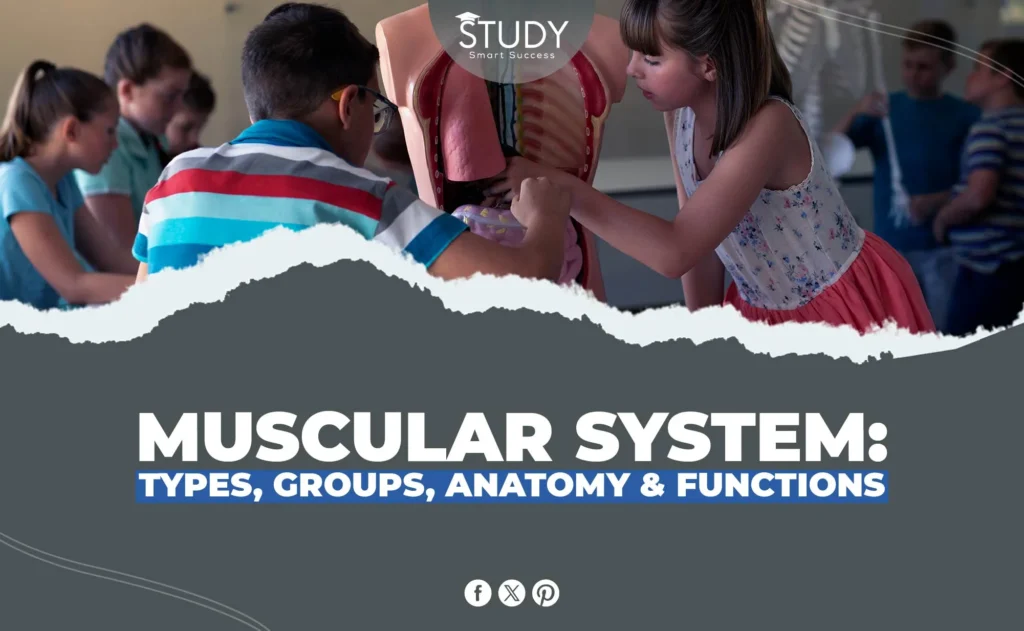Introduction
There are over 600 muscles in your body, and about 40% of your body weight is made up of muscles. Your muscular system, which you don’t even realize, helps you move, breathe, and keep your back straight all day long.
Maintaining health and fitness requires understanding the muscular system. Your muscles are essential in every movement, whether lifting weights, sprinting, or carrying groceries. Understanding how your muscles work helps you care for them and enhance your health.
This blog covers human muscle types, major muscle groups, anatomy, and functions. By the end, you’ll learn how this fantastic system works and why it’s essential to keep it healthy.
Read more about the Skeletal System.
What is the Muscular System?
The muscular system is a complex network of tissues that allows movement, posture, and critical physical functions. This muscular fiber-based system facilitates intentional and involuntary activities, including walking and heartbeat.
Components:
The muscular system has three main parts: muscles, tendons, and connective tissues.
Muscles: Body muscles generate force and movement. Long, slender muscle fibers contract and relax. Skeletal, cardiac, and smooth muscles work differently. Bone-attached voluntary skeletal muscles control movement. Smooth muscles in organ walls regulate digestion and blood flow, while cardiac muscles pump blood.
Tendons: Tendons are stiff, fibrous structures that connect muscles to bones. Collagen fibers make them robust and tension-resistant. Tendons transfer muscle force to the bones, permitting movement. During biceps contraction, the tendon linked to the forearm bone pulls the bone, bending the elbow.
Connective Tissues: Muscles are supported by fascia. Muscles are supported and friction-free by thin fascia. Ligaments and other connective tissues support joint movement. These tissues transfer muscle contraction force for effective, injury-free movement.
Types of Muscles in the Human Body
Skeletal Muscles
The tendons that join skeletal muscles to bones allow voluntary movement. Muscle fiber arrangement makes these muscles striated under a microscope. Humans can walk, play music, and more because their skeletal muscles are under conscious control.
Functions:
Muscles in the skeleton are essential to the body because they:
- Movement: Walking, running, pulling, and grasping are the main things that make body movements possible.
- Posture: Skeletal muscles help maintain good posture by keeping the body stable and in the right place, whether standing, sitting, or lying down.
- Protection: They also protect the internal organs by being a barrier, absorbing hits, and supporting the whole body.
Cardiac Muscles
Cardiac muscles are heart-specific. Unlike skeletal muscles, these striated muscles are not voluntary. Without rest, cardiac muscles circulate blood throughout the body. The heart’s pacemaker allows them to contract rhythmically and automatically, making them distinctive.
Functions:
The heart muscles are essential for
- Pumping Blood: They contract and relax rhythmically to help the heart circulate blood to all areas of the body, providing oxygen and nutrients to tissues and eliminating waste.
- Maintaining Blood Circulation: Heart muscles ensure that blood flows continuously, which is necessary for life and helps all body systems work.
Smooth Muscles
Smooth muscles line the digestive tract, blood arteries, bladder, and uterus. Involuntary muscles regulate automatic physiological activities.
Functions:
Smooth muscles execute numerous essential involuntary functions:
- Digestion: As they contract and relax rhythmically, they help move food through the digestive system. This is called peristalsis.
- Blood Flow: Blood pressure and flow are regulated by smooth muscle dilatation and constriction in blood vessel walls.
- Other Involuntary Movements: Other autonomic functions include bladder emptying and uterine contractions after birthing.
Skeletal, cardiac, and smooth muscles support voluntary and involuntary body functions.
Primary Muscle Groups and Their Functions
Upper Body
Deltoids
Three deltoid muscles surround the shoulder: anterior, lateral, and posterior. These muscles raise the arm for abduction and rotation. The anterior delta is beneficial for forward lifting and internal rotation, the lateral delta for arm abduction, and the posterior delta for arm extension and external rotation.
Pectorals
The pectoralis major and minor dominate the pectoral muscles. The enormous, fan-shaped pectoralis major covers most of the chest. It performs adduction, internal rotation, and flexion. Under the pectoralis major, the minor stabilizes the scapula during arm motions.
Biceps
The biceps brachii are on the front of the upper arm. This muscle’s long and short heads flex the elbow to bend the arm. The biceps help supinate the forearm, which rotates the palm upward.
Triceps
Triceps brachii are on the rear of the upper arm. This muscle has long, lateral, and medial heads. The triceps mainly straighten the arm by extending the elbow. Pushing a door or completing a push-up requires arm extension, which the triceps provide.
Latissimus Dorsi
The latissimus dorsi, or “lats,” are big, flat muscles on the lower back. They control shoulder adduction, extension, and internal rotation. The lats help draw anything toward the body in rowing, swimming, and climbing.
Trapezius
Triangular trapezius muscles, or “traps,” stretch from the cranium base to the middle of the back and shoulders. Upper, middle, and lower trapezius. The upper traps shrug, the intermediate traps retract shoulder blades, and the lower traps compress them. They support posture, neck, head, shoulder, and arm movement.
Lower Body
Abdominals
Rectus, obliques, and transverse abdominis are abdominal muscles. The most famous “six-pack” muscle is the rectus abdominis, which flexes the spine in crunches and sit-ups. The abdominal obliques allow trunk rotation and lateral flexion. The transverse abdominis stabilizes the core and maintains internal pressure to protect the organs and spine.
Gluteals
Gluteus maximus, medius, and minimus are gluteal muscles. The gluteus maximus, the body’s most significant muscle, extends, rotates, and abducts the hip. Climbing stairs, standing up, and running depend on it. The hip-side gluteus medius and minimus stabilize the pelvis and abduct the thigh.
Quadriceps
The quadriceps—rectus femoris, vastus lateralis, vastus medialis, and vastus intermedius—are four front-thigh muscles. These muscles must extend the knee to walk, run, jump, and stand up. The rectus femoris aids hip flexion.
Hamstrings
The back of the thigh has three hamstring muscles: the biceps femoris, semitendinosus, and semimembranosus. These muscles control knee flexion and hip extension, which are essential for running, jumping, and bending.
Gastrocnemius
The gastrocnemius, a big calf muscle, dominates the lower leg. Its two heads give it a unique shape. The gastrocnemius controls plantar flexion, which helps you push off while walking or running. It aids knee flexion.
Soleus
The flat, broad soleus muscle lies beneath the gastrocnemius. It aids foot plantar flexion, especially when the knee is bent. The soleus is essential for balance and posture during prolonged standing or walking.
Understand these muscles and their functions to optimize workouts, enhance posture, and reduce injury risk. These muscles cooperate to enable our daily movements.
Anatomy of Muscles
Muscle Structure
Muscle Fibers:
Fibers form muscles. These long, cylindrical cells contract muscles. Each muscle fiber is made up of sarcomere-based myofibrils and nuclei. Muscle fiber contraction units are sarcomeres. Contracting muscle fibers shorten, providing force and movement.
Fascicles:
Muscles have bundles of muscular fibers. The perimysium supports each fascicle and arranges muscular fibers. By clustering muscular fibers, fascicles improve muscle contractions and force.
Tendons and Ligaments:
Strong, fibrous tendons join muscles to bones. They allow bone mobility by transferring muscle contraction force. Muscle contractions strain on the bone via the tendon. Ligaments connect bones. Ligaments support joints during muscle contraction by preventing excessive movement.
Muscle Contraction
Neuromuscular Junction:
Motor neurons signal muscle contraction at the neuromuscular junction. Nerve cells release acetylcholine into the synaptic cleft, the gap between neuron and muscle fiber. This neurotransmitter spreads electrical impulses via muscle fiber membrane receptors. This impulse contracts muscles.
Sliding Filament Theory:
Cellular muscle contraction is described by sliding filament theory. Actin sliding across myosin shortens the sarcomere and muscle fiber, causing muscular contraction. On actin filament binding sites, myosin heads cross-bridge. Rotating myosin heads force actin toward the sarcomere core. The muscle contracts and generates force by sliding ATP.
Understanding muscle architecture and how it works at the macroscopic and microscopic levels is crucial to understanding movement complexity and muscle health. Every part of the muscular structure helps the body perform daily chores and complex athletic feats, from fibers to tendons.
Functions of the Muscular System
Movement:
The skeletal system and muscles work together to make action possible. When they contract, muscles pull on bones, allowing people to walk, lift things, and do other more complicated things.
Stability:
Joints are stable because muscles keep them in place. Postural muscles keep the body straight, and joint-stabilizing muscles keep the joints from dislocating and control actions.
Circulation:
The heart muscles move blood around the body, and smooth muscles in blood vessels control blood flow by narrowing or widening them depending on the body’s needs.
Digestion:
Smooth muscles in the digestive tract move food through the system through rhythmic movements, helping to break down food and absorb nutrients.
Heat Production:
Muscle movements make heat, which helps the body keep its temperature steady, especially when it’s cold outside, like when you shiver.
These tasks show how essential the muscular system is for movement, stability, blood flow, digestion, and keeping the body at the right temperature.
Common Muscle-Related Conditions
Muscle Strain:
Overactivity or incorrect motions stretch or tear muscle fibers, causing strain. Pain, edema, and immobility occur. RICE, painkillers, and physical therapy are used to treat it.
Tendinitis:
Tendonitis, which affects the shoulder, elbow, and knee, is caused by repetitive action or overuse. Pain and tenderness surround the damaged area. Rest, ice, anti-inflammatories, and strengthening exercises are used.
Muscle Atrophy:
Muscle atrophy, which weakens and shrinks muscles, is caused by inactivity, aging, and disease. Regular exercise, resistance training, and a protein-rich diet prevent muscular atrophy.
Muscle Cramps:
People often get muscle cramps because they are dehydrated, have a chemical imbalance, or use their muscles too much. Stretching, rubbing, and drinking plenty of water can help.
Myofascial Pain Syndrome:
Myofascial Pain Syndrome characterizes the persistent illness. Overuse or stress produces deep muscular soreness and tender spots. Trigger point injections, relaxation, and physical therapy are used.
These points show how important it is to keep your muscles healthy by exercising regularly, staying hydrated, and avoiding injuries.
Maintaining a Healthy Muscular System
Exercise:
Regular physical activity, including strength training and aerobic exercises, is crucial for building and maintaining muscle mass, improving endurance, and avoiding injuries.
Nutrition:
An adequate protein, vitamin, and mineral diet aids muscle repair, growth, and function. Muscles need protein, vitamin D, calcium, and magnesium.
Rest and Recovery:
Muscle repair and growth require enough sleep. Rest days and sleep reduce overtraining and injury risk.
Hydration:
Proper hydration is essential for muscle function, cramp prevention, and rehabilitation. Drink enough water before, during, and after exercise.
Stretching and Flexibility:
Stretching daily makes you more flexible, loosens tight muscles, and prevents injury. Practices like yoga also make you more flexible and improve the health of your muscles in general.
Maintaining a robust, healthy muscular system depends critically on these habits.
Conclusion
The muscular system depends on movement, stability, and critical biological functions. Maintaining muscle strength and resilience requires frequent exercise, appropriate nutrition, rest, hydration, and flexibility training. These routines improve physical performance and long-term health, helping you live an active and healthy life.


